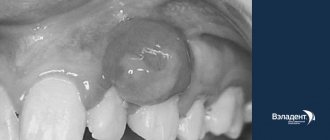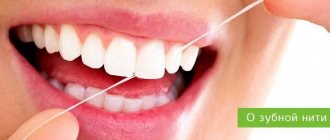After implantation, a realistic copy of it appears in place of the lost tooth. Both in appearance and in feel, the new and old units of the series are almost identical, so the patient quickly gets used to the prosthetic structure. And over time, he often forgets that he needs to treat her with care. The result may be the following situation: the crown has fallen off the implant and now it is unclear what to do with it. In this case, you should not be upset, nor should you try to secure the prosthesis yourself, using glue or other improvised means.
Content
- Causes
- What to do if a crown falls out
- What can't you do?
- What to do if you can’t see a doctor right away
- What will the doctor do?
- How to prevent hair loss
The use of modern high-quality and high-tech materials does not make the service life of crowns unlimited. A dental crown has a specific lifespan of 12 years. Sometimes it happens that the crown falls out. Immediately after this trouble, increased sensitivity of the stump may appear. Contact your doctor without delay. If this is not possible, follow your doctor’s recommendations to save the tooth and reduce discomfort as much as possible.
Content:
- Why do crowns fall out?
- When can the prosthesis be returned?
- When it is impossible to return a fallen prosthesis to its place 3.1. Loss of prosthesis with stump or pin 3.2. It is necessary to re-treat the dental canals 3.3. Loss along with natural root
- General recommendations in case of crown loss
- Preventing the problem from occurring
In dental practice, situations sometimes occur when a crown falls off.
Having realized what happened, the patient usually experiences fear. He experiences a state of panic, as he fears that it will no longer be possible to restore the repeatedly destroyed unit. No need to worry too much. The first thing you need to do is urgently seek qualified dental care. The doctor will assess the condition of the stump and the fallen prosthesis and tell you whether everything can be returned to its place.
Why is this happening
The following reasons for loss are possible:
- The service life of the cement has expired, the composition has lost its fastening properties - the crown has decemented;
- The patient put too much stress on the crown by including hard foods in the menu;
- During installation, temporary cement was used, which had to be replaced at the appointed time;
- A destructive process was underway under the crown - caries developed, as a result, the tightness of the connection was broken;
- The person often consumed chewing candies and toffees - the viscous consistency of the products contributed to the tearing of the crown from the tooth;
- The crown was placed on a tooth that was too small, and the insufficient tooth height reduced the bond;
- The size of the crown exceeded the size of the stump;
- The tooth stump turned out to be pointed, so the crown was weakly fixed;
- The material used to make the prosthesis was not strong enough.
PROMOTION
Installation of crowns, dental bridge
RUB 3,450
When it is impossible to return a fallen denture to its place
Unfortunately, in most clinical cases it is not possible to glue the crown back. This is due to the fact that after re-fixation it no longer fits tightly to the stump, which means that food debris will constantly get clogged under it. Soft tissues will often begin to become inflamed - conditions will be created for the destruction of the dentogingival apparatus.
A product that has fallen off cannot be returned if:
- it fell out along with the pin or stump;
- there are indications for repeated filling of the root canals of the exposed unit;
- it fell out along with the natural root.
Let's look at each limitation in more detail.
Loss of prosthesis with stump or pin
This is possible if:
- at the stage of preparation for prosthetics, the doctor did not notice that the walls of the roots were very thin and fragile;
- the process of preparation for restoring the integrity of the dentition is disrupted;
- the adhesive base has disintegrated;
- After fixation of the prosthesis, the chewing load was distributed unevenly.
Helpful information . Today, dentists are trying to use inlays rather than pins. These structures are identical in their functions. But the pins can provoke deformation of the root and necrosis of the tissues located near it.
If the crown and the inlay/pin fall out, it is advisable to visit a doctor on the same day. If you ignore the problem, pathogenic organisms may begin to multiply in the opened area. They can spread to the jaw bones. Then the therapy will be long and complex.
It is necessary to re-treat dental canals
Quite often, the product falls out due to a progressive inflammatory process in the root canals. Then the stump ceases to fit tightly to the walls and becomes mobile. Following this, the prosthesis begins to wobble.
Detecting the inflammatory process is not difficult - it is clearly visible on an x-ray. To remove it, the doctor performs repeated cleaning of the roots. Then, according to the new parameters, a suitable orthopedic system is manufactured.
It also happens that hard tissues are in unsatisfactory condition. Then they are further reinforced with a tab. If it turns out that the root is cracked or partially destroyed, there is only one way out - removal.
Loss along with natural root
Sometimes the entire unit falls out, that is, the separation of the artificial crown part from the natural roots does not occur. This happens when:
- cyst;
- granuloma;
- periodontal pathologies.
It is clear that here we can no longer talk about any restoration measures. The doctor takes a picture and examines whether there are any root remains in the soft tissues. If necessary, remove them surgically.
To close the void that appears in the dentition, the specialist suggests implanting a pin and subsequent fixation of the implant or making a dental bridge. In any case, the defect should be closed as quickly as possible, as it can lead to malocclusion and atrophy of hard jaw tissues.
What to do if it is not possible to see a doctor immediately
- Apply clove oil to the tooth and the pain will decrease.
- Wash the crown and install it on the tooth using cement, which is sold in the pharmacy chain. It is not advisable to do this, but if you contact your dentist and get the go-ahead, you can fix the product temporarily, according to the recommendations of a specialist. You should first rinse your mouth with an antiseptic.
- If necessary, you can take painkillers.
- If the crown falls off and cannot be found, you can simply lubricate the tooth with pharmaceutical cement - this technique will somewhat reduce the discomfort.
Preventing the problem from occurring
To reduce the likelihood of dental structures falling out, you should:
- Be treated only in a trusted medical center. Particular attention should be paid to the doctor’s qualifications and work experience. There is no need to look for cheap dentures in the city - price should be the last criterion when it comes to oral health. Main quality.
- Follow all medical prescriptions. Usually the doctor explains in detail how to extend the life of the system. His recommendations should be kept in mind.
- Treat the artificial unit with care. It is unacceptable to chew nuts, foreign objects, open bottles with your teeth, etc.
- Follow the rules of oral hygiene. It is recommended that the crown, like the natural teeth surrounding it, be cleaned with toothpaste and a brush at least twice a day. It is impossible for plaque to be deposited on its surface and stone to form.
- Have preventive dental examinations annually. During them, the doctor examines the condition of the oral cavity and takes measures to prevent the development of dental diseases.
Take care of your teeth. Then your smile will remain beautiful for many years.
Possible options
If the old crown can be used, it will be reinstalled using fresh temporary dental cement. The patient will have the opportunity to wear the crown again for some time; if discomfort does not arise, the fixation will be performed with permanent cement. If wearing it is impossible, the dentist will offer to make a new crown and give reasons for his recommendations.
Minor damage to the crown (chips) can be repaired. Significant damage cannot be repaired. A new product will need to be manufactured.
When can the prosthesis be returned?
Sometimes the fallen protection can be returned to the oral cavity. So, it’s possible to correct the situation if:
- the stump is not damaged or affected by caries;
- The “cap” remains intact, there are no cracks, chips or scratches on it.
Then the doctor carries out an antiseptic treatment of the base and removes any remaining glue from its surface. Then the structure is re-fixed with dental cement.
It is important not to delay visiting a specialist. The prepared unit covered by the prosthesis is always very fragile. It is not able to withstand the chewing load. If you don't cover it in time, it will most likely break. Then you will have to carry out prosthetics from the very beginning or, even worse, remove the roots and carry out implantation.
What you should absolutely not do
The main prohibition in this case is the prohibition on installing a crown yourself. Without a professional fixing compound, it will not be possible to achieve the required strength. And using the first glue you come across instead is, firstly, extremely dangerous, and secondly, it still won’t give the desired result.
It is very likely that the crown will fall out of place again and in doing so will enter the respiratory tract and cause suffocation. Ultimately, this can even lead to death.
Simply put, only a dentist can place a crown correctly.
Procedure for a fallen crown
- First of all, the crown must be washed and placed in a cool place.
- Then you need to rinse your mouth with an antiseptic solution.
- Next, you need to close the implant from which the crown has fallen off with a cotton swab.
- If you have a toothache, you should take a pain reliever.
- And finally, the most important thing: in such a situation, you need to see a dentist as soon as possible.
Of course, you need to take the fallen crown with you. There is a chance that the doctor will put it back. Although another development of events is possible - under certain conditions (they will be discussed below), the dentist may decide to make a new design.
The implant fell out, what should I do?
In rare cases, the implant becomes unscrewed from the bone and may fall out. This occurs when the size of the socket and the intraosseous element do not match, as well as due to the weakness of the jaw bone. Such situations, when the implant loses its fixation and falls out, but there is no inflammation or other signs of rejection, can occur against the background of systemic diseases in which tissue regeneration is impaired (osteoporosis, diabetes mellitus). The problem is solved by reinstalling the structure using regenerative membranes (enriched with growth factors) that accelerate osseointegration, and prescribing a course of vitamin therapy.
Signs
Signs of the onset of rejection, which can cause implant loss, include:
- swelling of the gums, deterioration of the condition a week after installation of the prosthesis;
- redness of the mucous membrane;
- acute, severe pain, the appearance of the syndrome after exercise or spontaneously;
- bleeding at the site of implantation of the artificial root;
- pus, unpleasant, putrid odor;
- the structure becomes movable;
- increase in body temperature, the Patient's condition worsens.
In the absence of treatment, deformation of the gums develops around the affected area, soft and hard tissues become necrotic. In case of rejection, spontaneous removal of the artificial root is observed, which is accompanied by severe pain.
What size should the ground base (stump) be for installing a crown?
- as high as possible: in this case, the structure will effectively withstand lateral loads (when the jaw moves to the sides) and will not break along with the tooth,
- as wide as possible, have parallel side walls (i.e., close in shape to a cylinder): many dentists grind the stump in the form of a “herringbone” or cone, leaving the top thin and not resistant to loads. The key to high-quality fixation is the maximum preservation of your own tissues and the correct shape, which allows you to withstand normal chewing pressure,
- at the base of the ground stump there should be a ledge or a small step, which ensures a tight fit of the crown to its own tissues in the gum area.









